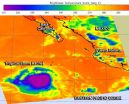(Press-News.org) Young individuals of a species are often more sensitive towards environmental stress than their adult counterparts. Scientists from GEOMAR Helmholtz Centre for Ocean Research Kiel now observed this effect in the sea star Asterias rubens from the Baltic Sea. In a long-term laboratory experiment that was conducted in the framework of the German research network BIOACID (Biological Impacts of Ocean Acidification), the researchers simulated three different levels of acidification that could be reached in the Baltic Sea by the uptake of additional carbon dioxide (CO2) within the coming decades. The results showed that even at slightly increased acidification, the small sea stars grew more slowly and ate less. "In adult sea stars, we only observed this effect at significantly higher carbon dioxide concentrations in the water", Dr. Jörn Thomsen explains. Thomsen is one of the two first authors of the long-term study that has been described in the journal "Marine Ecology Progress Series". It was observed that the animals could not adapt to the acidified conditions even after a very long acclimation period.
The sea star Asterias rubens is one of the most important benthic species is in the Western Baltic. As important predators, they keep the mussel population under control. "If the sea stars suffer from the effects of ocean acidification, it could affect the entire ecosystem in the long run", concludes Dr. Yasmin Appelhans, the other first author of the new study. "For example, only a few sea stars live in the Bay of Lübeck, because of the low salinity there. The mussels in this region can spread unhindered and outcompete other species."
It is not yet fully understood why the majority of the young sea stars develop poorly under elevated CO2 conditions in the laboratory. However, the study showed that the sea stars did not store less calcium carbonate in their skeletons under acidification. "They might grow less because they need more energy to form calcium carbonate", Thomsen assumes. "The fact that they eat less might also indicate that the acidic water affects the digestive enzymes."
A few individuals grew well even under a high CO2. Appelhans: "If these tolerant animals succeed, sea stars could possibly adjust to new environmental conditions. For some species, there are already indications that an adaptation by evolution is possible. Whether this also applies to the sea stars should be investigated in the future. At the same time, it is important verify the observations from the lab under more natural conditions."
INFORMATION:
Original publication:
Appelhans, Y.S., Thomsen, J., Opitz, S., Pansch, C., Melzner, F., Wahl, M. (2014): Juvenile sea stars exposed to acidification decrease feeding and growth with no acclimation potential. Mar. Ecol. Prog. Ser., 509, 227-239, doi: 10.3354/meps10884
Links:
GEOMAR Helmholtz Centre for Ocean Research Kiel
BIOACID Biological Impacts of Ocean Acidification
BIOACID in brief:
Under the umbrella of BIOACID (Biological Impacts of Ocean Acidification), 14 institutions examine how marine ecosystems react to ocean acidification, how this affects the food web and the exchange of material and energy in the ocean and how the changes influence the socio-economic sector. The project started in 2009 and entered its second three-year funding period in September 2012. The Federal Ministry of Education and Research (BMBF) supports the current work with 8.77 million Euros. The work is coordinated by GEOMAR Helmholtz Centre for Ocean Research Kiel. A list of member institutions, information on the scientific programme and the BIOACID committees as well as facts about ocean acidification can be found on the website http://www.bioacid.de.
Contact:
Dr. Jörn Thomsen (GEOMAR, FB3-EÖ-B), jthomsen@geomar.de
Maike Nicolai (GEOMAR, Kommunikation & Medien), Tel.: 0431 600-2807, mnicolai@geomar.de
Sensitive youngsters
Young sea stars react more sensitively to ocean acidification than adults
2014-09-26
ELSE PRESS RELEASES FROM THIS DATE:
Study identifies unexpected clue to peripheral neuropathies
2014-09-26
CINCINNATI – New research shows that disrupting the molecular function of a tumor suppressor causes improper formation of a protective insulating sheath on peripheral nerves – leading to neuropathy and muscle wasting in mice similar to that in human diabetes and neurodegeneration.
Scientists from Cincinnati Children's Hospital Medical Center report their findings online Sept. 26 in Nature Communications. The study suggests that normal molecular function of the tumor suppressor gene Lkb1 is essential to an important metabolic transition in cells as peripheral nerves (called ...
NASA identifies cold cloud tops in Tropical Storm Rachel
2014-09-26
NASA's Aqua satellite saw the area of strong thunderstorms with colder cloud tops had grown within the Eastern Pacific Ocean's Tropical Storm Rachel.
NASA's Aqua satellite passed over the large Tropical Storm Rachel on Sept. 25 at 4:41 p.m. EDT and the Atmospheric Infrared Sounder or AIRS instrument, saw that the extent of colder cloud tops had increased, indicating thunderstorm heights were increasing and it was strengthening. The expansion of those stronger thunderstorms also suggests that the northeasterly wind shear may be relaxing a little. The strongest thunderstorms ...
Underwater robot for port security
2014-09-26
Last week, at the International Conference on Intelligent Robots and Systems, MIT researchers unveiled an oval-shaped submersible robot, a little smaller than a football, with a flattened panel on one side that it can slide along an underwater surface to perform ultrasound scans.
Originally designed to look for cracks in nuclear reactors' water tanks, the robot could also inspect ships for the false hulls and propeller shafts that smugglers frequently use to hide contraband. Because of its small size and unique propulsion mechanism — which leaves no visible wake — the ...
Penn team studies nanocrystals by passing them through tiny pores
2014-09-26
An interdisciplinary team of University of Pennsylvania researchers has now applied a cutting-edge technique for rapid gene sequencing toward measuring other nanoscopic structures. By passing nanoscale spheres and rods through a tiny hole in a membrane, the team was able to measure the electrical properties of those structures' surfaces.
Their findings suggest new ways of using this technique, known as "nanopore translocation," to analyze objects at the smallest scale.
The research was led by Marija Drndić, professor in the Department of Physics and Astronomy ...
Geisel researchers contribute to study of trained immunity
2014-09-26
Hanover, NH - A study published in the journal Science provides support for a new—and still controversial—understanding of the immune system. The research was conducted by collaborators in the U.S. and Europe, including Robert Cramer, PhD, an assistant professor of microbiology and immunology at the Geisel School of Medicine and member of the Dartmouth Lung Biology Center, and Kelly Shepherdson, PhD, at the time a graduate student in Cramer's lab.
Typically, scientists divide the immune system into two categories: the innate immune response and the adaptive immune response. ...
New UT Dallas technology may lead to prolonged power in mobile devices
2014-09-26
Researchers from The University of Texas at Dallas have created technology that could be the first step toward wearable computers with self-contained power sources or, more immediately, a smartphone that doesn't die after a few hours of heavy use.
This technology, published online in Nature Communications, taps into the power of a single electron to control energy consumption inside transistors, which are at the core of most modern electronic systems.
Researchers from the Erik Jonsson School of Engineering and Computer Science found that by adding a specific atomic ...
High-throughput cell-sorting method can separate 10 billion bacterial cells in 30 minutes
2014-09-26
University of Hawaii at Manoa College of Engineering mechanical engineer Yi Zuo has developed a new, high-throughput method for sorting cells capable of separating 10 billion bacterial cells in 30 minutes.
The finding has already proven useful for studying bacterial cells and microalgae, and could one day have direct applications for biomedical research and environmental science—basically any field in which a large quantity of microbial samples need to be processed.
The new method was described in a September 2014 publication in the scientific journal Analytical Chemistry, ...
New scientific review of genetically engineered feeds in livestock diets
2014-09-26
An article published in the peer-reviewed Journal of Animal Science concludes feeding livestock diets that contain genetically engineered (GE) crops has no impact on the health or productivity of those animals. In a thorough review of scientific literature and field data sets, the article documents evidence that the performance and health of food-producing animals fed GE crops are comparable with those of animals fed non-GE crops.
Since their introduction in 1996, GE feed crops have become an increasing component of livestock diets. Today, more than 95 percent of U.S. ...
Experts call for widening the debate on climate change
2014-09-26
Environmental scientists are being urged to broaden the advice they give on global climate change, say experts who are also frustrated that decision makers are not taking enough action.
Writing in the journal Nature Climate Change, The University of Manchester researchers argue that scientists are expressing a strong desire to fix the problems highlighted by their studies into human-induced climate change
The authors suggest there are problems with environmental scientists offering practical solutions that can help societies adapt to a fast-changing Earth - one where ...
How plankton gets jet lagged
2014-09-26
A hormone that governs sleep and jet lag in humans may also drive the mass migration of plankton in the ocean, scientists at the European Molecular Biology Laboratory (EMBL) in Heidelberg, Germany, have found. The molecule in question, melatonin, is essential to maintain our daily rhythm, and the European scientists have now discovered that it governs the nightly migration of a plankton species from the surface to deeper waters. The findings, published online today in Cell, indicate that melatonin's role in controlling daily rhythms probably evolved early in the history ...
LAST 30 PRESS RELEASES:
Mount Sinai Health system receives $8.5 million NIH grant renewal to advance research on long-term outcomes in children with congenital heart disease
Researchers develop treatment for advanced prostate cancer that could eliminate severe side effects
Keck Medicine of USC names Christian Pass chief financial officer
Inflatable fabric robotic arm picks apples
MD Anderson and SOPHiA GENETICS announce strategic collaboration to accelerate AI-driven precision oncology
Oil residues can travel over 5,000 miles on ocean debris, study finds
Korea University researchers discover that cholesterol-lowering drug can overcome chemotherapy resistance in triple-negative breast cancer
Ushikuvirus: A newly discovered giant virus may offer clues to the origin of life
Boosting the cell’s own cleanup
Movement matters: Light activity led to better survival in diabetes, heart, kidney disease
Method developed to identify best treatment combinations for glioblastoma based on unique cellular targets
Self-guided behavioral app helps children with epilepsy sleep earlier
Higher consumption of food preservatives is associated with an increased risk of type 2 diabetes
NTU Singapore-led team captures first-ever ‘twitch’ of the eye’s night-vision cells as they detect light, paving the way for earlier detection of blindness-causing diseases
Global aviation emissions could be halved through maximising efficiency gains, new study shows
Fewer layovers, better-connected airports, more firm growth
Exposure to natural light improves metabolic health
As we age, immune cells protect the spinal cord
New expert guidance urges caution before surgery for patients with treatment-resistant constipation
Solar hydrogen can now be produced efficiently without the scarce metal platinum
Sleeping in on weekends may help boost teens’ mental health
Study: Teens use cellphones for an hour a day at school
After more than two years of war, Palestinian children are hungry, denied education and “like the living dead”
The untold story of life with Prader-Willi syndrome - according to the siblings who live it
How the parasite that ‘gave up sex’ found more hosts – and why its victory won’t last
When is it time to jump? The boiling frog problem of AI use in physics education
Twitter data reveals partisan divide in understanding why pollen season's getting worse
AI is quick but risky for updating old software
Revolutionizing biosecurity: new multi-omics framework to transform invasive species management
From ancient herb to modern medicine: new review unveils the multi-targeted healing potential of Borago officinalis
[Press-News.org] Sensitive youngstersYoung sea stars react more sensitively to ocean acidification than adults



